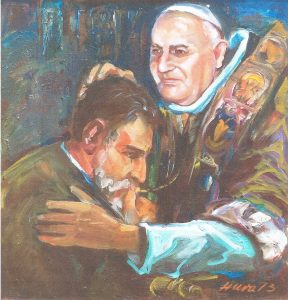“Lead, Kindly Light, amid the encircling
Gloom,
Lead thou me on!
The night is dark, and I am far from
Home –
Lead thou me on!”
(John Henry Cardinal Newman)
Art is the ultimate revelation of human greatness. Only an inspired artist can fathom the depth of human suffering and find the strength to overcome it.
It was truly a dark night for the Ukrainian people when Soviet terror reigned over their land. But amid the encircling gloom there was Light. It shone from the distant vastness of Siberia, from the steppes of Kazakhstan, from the prisons and labor camps of the Gulag. The Light was the word of Josyf Slipyj, truly a lux in tenebris. He was the Archbishop Metropolitan of Lviv, who spent 18 years as a prisoner of the Soviet regime. His letters and epistles, written clandestinely and under great peril, inspired his flock and firmed their faith in God:
“Be witnesses to Christ in Ukraine and in the lands of your voluntary and involuntary settlement; in all the lands where you dwell, in prisons, in dungeons and in concentration camps; to the end of the earth and to the last moment of your earthly lives! Be witnesses on every continent of our poor planet! Do not put to shame our Ukrainian land – the land of our ancestors! Maintain in your souls, pure and undefiled, the name of Your Holy Church! Do not put to shame your Ukrainian heritage…”
No journalist, no historian has thus far been able to capture the indomitable spirit of this Confessor of Faith, who could not be broken nor bought, neither for rubles nor for dollars. Only poets and artists have revealed to us the quintessence of his inner strength, his ability to overcome torture and privation. Among these artists is Jurij Hura. His rich paintings provide unique insight into the nature of the prisoner, who became the patriarch of his Church, and chronicle his long and arduous path per aspera ad astra. In his seminal work on ancient Greece, the 18th century German scholar Johann Joachim Winckelmann stated that the salient characteristic of Greek art is “a noble simplicity and a quiet grandeur.” Hura’s paintings unveil for us these precious human qualities in Josyf Slipyj’s soul. In this sense, they reveal to us, if only partially, the mystery of martyrdom, perhaps even, depending on the viewer’s background, the mystery of Christianity.
In his “Spiritual Testament,” written in Rome during the period of 1970 to 1981, Josyf Slipyj vividly recalls the horrors of Soviet imprisonment:
“Arrests by night, secret trials, endless interrogations, searches, moral and physical torment and humiliation, beatings, and murder by starvation; vile and dishonest prosecutors and judges; and before them I stand, a defenseless prisoner and convict, a ‘mute witness of the Church’, who weakened physically and psychologically emaciated, gave witness to his silent, beloved Church, which was condemned to death…And this prisoner-convict saw that his path ‘to the end of the earth’ ended in a death sentence!”
And yet, Josyf Slipyj persevered. He walked with firm strides on his via dolorosa, with a pure heart and an unwavering, simple, almost child-like faith, a faith that truly moves mountains. And all the time, he was growing spiritually in the comforting surety of belonging to the Silent Church of Latter Day Catacombs, a Church of Martyrs and Confessors of the Faith, who were doomed to death and immortality:
“I gained strength on this path of a prisoner for Christ only in the thought that I was accompanied by my spiritual flock, my beloved Ukrainian people, all the bishops, priests, faithful, fathers and mothers, infants, self-sacrificing youth, and helpless elderly. I was not alone!”
Indeed, he was not alone. The Ukrainian faithful all over the globe were with him in spirit and in prayer. They prayed for him and for their Church. They hoped for a miracle; and against all odds, a miracle happened. On the intercession of President John F. Kennedy and Pope John XXIII their spiritual leader was released from captivity in 1963. As a prince of the Church, he took his rightful place in Rome from where he vigorously exercised his patriarchal functions and prerogatives.
On October 11, 1963, in addressing the Fathers of the Second Vatican Council, he focused the attention of the world on the fate of his Church and her faithful, who had “sacrificed mountains of bodies and shed rivers of blood for their faith and their fidelity to the Holy See.” Filled with a dynamic spirit and boundless energy, the former prisoner of the Gulag built a Ukrainian center in Rome. On its outskirts he founded the St. Clement Pope Ukrainian Catholic University, he built the golden-domed Cathedral of St. Sophia and, in the center of the city, within walking distance of the Coliseum, he re-purchased and restored the building complex housing the ancient Ukrainian Church of the Blessed Virgin of Zhyrovytsi and SS. Sergius and Bacchus, which had previously been sold to a private non-Ukrainian owner. He also established the Studion monastery on the hills surrounding Rome, ensuring a marked Ukrainian presence in the Eternal City. His numerous visitations of the Ukrainian communities throughout the world rallied the faithful endowing them with a sense of pride of belonging to the largest Eastern Church in Union with the Holy See of Rome.
Patriarch, pastor, and teacher of his people, the Confessor of the Faith Josyf Slipyj was also a patron of the arts. The St. Sophia Cathedral, its icons and mosaics and its environs are eloquent testimony of this part of his heritage. Thus, it is most fitting that now, after he is gone to “God who is our Home,” his immortality here on earth is preserved in the beautiful paintings of a great master.
Leonid Rudnytzkyy
These reflections are the foreword for Jurij Hura’s forthcoming album. For Maestro’s masterpieces please visit: http://huraartgallery.com

